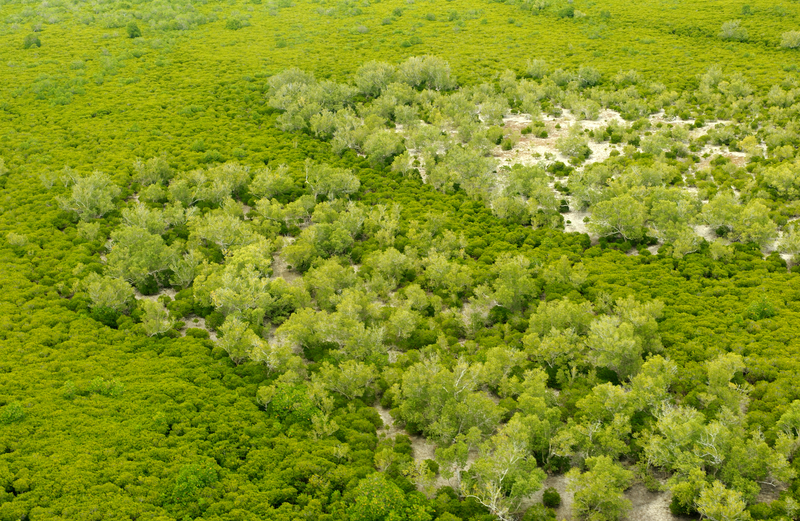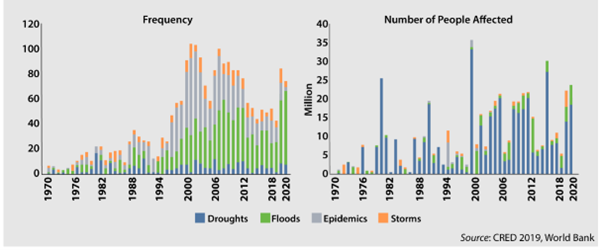Protecting The Mozambican Mangroves: Preservation Through Innovation And Emerging Technologies

This is the 35th post in a blog series to be published in 2022 by the Secretariat on behalf of the AU High-Level Panel on Emerging Technologies (APET) and the Calestous Juma Executive Dialogues (CJED)
AU Member States suffer disproportionately from the adverse impacts of climate change compared to the rest of the world. Under all climate change scenarios where the temperatures are increasing by 1.5°C, Africa remains the continent most susceptible to climate change's effects.[1] Natural disasters have become more common in Sub-Saharan Africa than in the rest of the world. Droughts have nearly tripled in frequency since the 1970s, storms have quadrupled, and floods have increased tenfold. As a result, Sub-Saharan Africa has experienced 20% of the global floods and more than one-third of the global droughts over the last decade (see figure 1).[2]

Figure 1: Natural Disasters in Sub-Saharan Africa (1970 - 2020)
As such, Africa is facing exponential collateral damage due to climate change as they are posing systemic risks to the continent's economy, infrastructural investments, water management, food systems, public health, agriculture, and livelihoods.[3] These climate change effects threaten to undo Africa's modest socio-economic developmental gains. This threatens to slip the African continent further into higher levels of extreme poverty, despite being the least contributor to global warming by transmitting the lowest emissions.[4]
Due to the continent's limited adaptive capacity and significant economic reliance on climate-related activities and goods, Africa is vulnerable to climate change. The weak and shaky institutional economic activities and inadequately established governance systems contribute to the limited adaptive potential. Notably, seven of the ten most vulnerable countries to climate change are in Africa. Among those, four AU Member States were reported to be among the top ten countries most affected by climate change in 2015.[5] For example, Mozambique was most negatively impacted by climate change and followed by Malawi, Ghana and Madagascar.[6]
The African Union's Agenda 2063 aspires to accomplish a prosperous Africa based on inclusive growth and sustainable development. Fundamentally, as most AU Member States depend on nature for their survival, climate change is deterring those hopes significantly.[7] For example, the February 2022 AU's Agenda 2063 Implementation Report highlighted that the continent's policies and frameworks aimed at enhancing climate adaptation were improperly and ineffectively implemented.[8] This was because the climate change curbing efforts on regulatory implementations were country-specific, yet the climatic conditions and natural resources transcended national boundaries. Therefore, this necessitated a well-coordinated response from all AU Member States.[9]
In response to the report, the 1st Continental Climate Change and Resilient Development Strategy and Action Plan (2022–2032), also known as the "AU Climate Strategy", was endorsed by the AU Heads of State and Governments in February 2022.[10] This plan adhered to the climate change mitigation guidelines outlined in pre-existing continental frameworks initiated to tackle climate change. These frameworks included the Africa Renewable Energy Initiative and the Africa Blue Economy Strategy.[11]
These strategies promote improved institutional collaborations and knowledge exchange sharing efforts amongst AU Member States on challenges and solutions about climate change.[12] Therefore, to effectively prevent and manage the conflicts related to climate change, the strategies emphasised the need to strengthen climate security institutional capacity by developing climate-sensitive approaches to climate change.[13],[14] Thus, utilising collaborative innovation, local innovation and natural means to address climate change effects is being encouraged and pursued in some AU Member States, including Mozambique.
Mozambique's long coastline makes the country more vulnerable to tropical storms and storm surge floods. Notably, more than half of the population resides along the low-lying coastal areas, endangering these coastal communities and their critical resources. As such, flooding and drought occurrences frequently threaten Mozambique's agricultural economic activities. Worth noting is that the agricultural sector in Mozambique employs approximately 75% of Mozambique's workers. Besides the economic ramifications, climate change is substantially raising the likelihood of widespread food insecurities and the occurrences of water-related illnesses.[15] Furthermore, agricultural development, wildfires, and overharvesting are the country's leading causes of greenhouse emissions, leading to massive climate disasters such as cyclones and extreme flooding.
Most recently, several cyclones have significantly hit Mozambique devastatingly. These cyclones include tropical cyclones such as Eloise and Idai between 2021 and 2022.[16] These cyclones brought devastating winds and extreme rainfalls in Beira and surrounding districts. Furthermore, these cyclones caused severe flooding that claimed lives and caused billions of dollars in damage.[17]
In response to these devastating climate change effects, the Mozambique government has implemented several climate change policies, including the restoration of mangrove forests, over the last ten years. Mangrove forests are an essential way of minimising the effects of cyclones and floods and adapting to climate change.[18] In Mozambique, mangroves are a group of trees and shrubs found in coastal intertidal zones and cover an area of approximately 396 080 hectares.[19] As such, these mangrove forests shield the coastline from storm surges with their extensive root systems, serving as natural barriers to floods and cyclones. The mangrove forests are also reducing the wave strength of cyclones and l coastal erosion. Consequently, this prevents the destruction of lives, livelihoods, and properties along the coastal lines.[20] Additionally, the mangrove forests serve as habitats for marine biodiversity by providing a conducive environment and microclimate for reproduction, performing critical ecological roles, and nourishment.
Nevertheless, due to urbanisation, industrial pollution, increasing sea levels, altered oceanic chemistry, and the usage of mangrove trees for building materials such as wooden stakes, Mozambican mangroves are in critical danger. As such, Maputo and Beira are experiencing the highest rates of mangrove destruction, estimated to be 1821 hectares per year.[21] Therefore, in light of the unsustainable and rapid depletion of these mangrove forests, the Mozambican government, in partnership with several developmental organisations, are safeguarding the mangrove forests. Therefore, emerging technologies are being adopted to enhance monitoring and management tools and mechanisms to address the disappearance of mangroves in Mozambique and counter the effects of climate change.[22]
The African Union High-Level Panel on Emerging Technologies (APET) encourages AU Member States to embrace technological advancements to improve data collection in forest management. This will enhance the efficiency and maintenance of the delicate forest ecosystems, especially the mangrove forests in Mozambique. APET advises that emerging technologies such as drone technologies, artificial intelligence (AI), blockchain-enabled management systems, and the internet of things can provide data generation and management systems of forests.[23] These forest management systems are essential in understanding the extent to which the mangrove forest population changes over time. This is beneficial in hard-to-reach areas [24] with respect to the collection of data that should also be accurate to ensure reliable prediction of mangrove growth along the coastal areas. The technological development in satellite images, such as hyperspectral imaging, can capture fine features from visible spectra.
An ambitious Mangrove Reforestation Plan was launched in 2022 by the Ministry of Sea, Inland Waters, and Fisheries (MIMAIP) of Mozambique in collaboration with the Blue Forest Company based in the United Arab Emirates.[25] This strategic plan involves the adoption of emerging technologies towards the restoration of the mangrove forests in Mozambique. This strategy recognises the significance of mangroves in addressing the effects of climate change currently facing Mozambique.[26]
For example, Light Detection and Ranging (LiDAR) technology is being utilised by Mozambique to identify the locations where the mangroves have been damaged by human activity.[27] This then informs the policy and action plans that should be undertaken to reduce environmental deterioration. The satellite data and field measurements are analysed using AI algorithms to tailor the reforestation activities precisely, efficiently, and transparently. With this project, Mozambique is aspiring to utilise the LiDAR technology supported by AI algorithms to enhance the impact and efficiency of Mozambique's reforestation efforts.
In conclusion, mangrove forests have an imperative role in reducing the impacts of climate change, even though these kinds of forests constitute only 1% of all tropical forests worldwide. Furthermore, mangrove forest soils are effective carbon sinks by their capacity to store a significant amount of carbon dioxide and prevent carbon dioxide gas from escaping into the atmosphere. Additionally, mangroves are enabling Mozambican society to adapt to the effects of climate change by minimising the effects of storms and sea level rise. Therefore, African countries with coastal sites are encouraged to replicate the mangrove forests and adopt emerging technologies to manage them. Most importantly, enhancing the rejuvenation of the mangrove forest ecosystem should be part of the continental efforts to address the impacts of climate change.
Featured Bloggers – APET Secretariat
Justina Dugbazah
Barbara Glover
Bhekani Mbuli
Chifundo Kungade
Nhlawulo Shikwambane
[1] https://www.afdb.org/en/cop25/climate-change-africa.
[2] https://africacenter.org/spotlight/how-global-warming-threatens-human-security-in-africa/
[3] https://unfccc.int/news/climate-change-is-an-increasing-threat-to-africa.
[4] https://www.europarl.europa.eu/RegData/etudes/BRIE/2022/738201/EPRS_BRI(2022)738201_EN.pdf.
[5] https://www.concern.net/news/countries-most-affected-by-climate-change.
[6] https://www.afdb.org/en/cop25/climate-change-africa.
[7] https://au.int/en/agenda2063/aspirations.
[8] https://au.int/sites/default/files/documents/41480-doc-2nd_Continental_Progress_Report_on_Agenda_2063_English.pdf.
[9] https://au.int/en/pressreleases/20221024/impact-climate-induced-migration-achieve-africa-we-want.
[10] https://www.europarl.europa.eu/RegData/etudes/BRIE/2022/738201/EPRS_BRI(2022)738201_EN.pdf.
[11] https://archive.uneca.org/sites/default/files/uploaded-documents/ACPC/2020/africa_climate_change_strategy_-_revised_draft_16.10.2020.pdf.
[12] https://www.au-ibar.org/sites/default/files/2020-10/sd_20200313_africa_blue_economy_strategy_en.pdf.
[13] https://www.europarl.europa.eu/RegData/etudes/BRIE/2022/738201/EPRS_BRI(2022)738201_EN.pdf.
[14] https://www.afdb.org/en/news-and-events/press-releases/blue-economy-africa-african-development-bank-explores-continents-shore-renewable-energy-potential-47167.
[15] https://climateknowledgeportal.worldbank.org/sites/default/files/2019-06/CSA-in-Mozambique.pdf.
[16] https://www.ifrc.org/emergency/mozambique-2021-2022-floods-and-cyclones.
[17] https://www.ifrc.org/emergency/mozambique-2021-2022-floods-and-cyclones#:~:text=Tropical%20Cyclone%20Eloise%20hit%20Mozambique,lives%20and%20caused%20massive%20damage.
[18] https://landportal.org/news/2022/01/mozambique-recovery-mangroves-key-climate-change-adaptation.
[19] https://ceppag.uem.mz/images/pdf/SA_TIED_WP_136.pdf.
[20] https://www.fairplanet.org/story/can-ai-help-resuscitate-mozambiques-mangrove-forests/.
[21] Barbosa, Filomena & Cuambe, C.C. & Bandeira, Salomão. (2001). Status and distribution of mangroves in Mozambique. South African Journal of Botany. 67. 393-398. 10.1016/S0254-6299(15)31155-8.
[22] https://biofund.org.mz/wp-content/uploads/2019/01/1548945134-F1021.Balancing%20Development%20and%20Coastal%20Conservation_%20Mangroves%20in%20Mozambique.pdf.
[23] https://www.ifc.org/wps/wcm/connect/1f00b57b-3f6b-4be9-ad6a-af8ea87a0581/EMCompass_Note+76-AI+and+5G+in+Emerging+Markets_FIN+for+WEB.pdf?MOD=AJPERES&CVID=mYsdFhr.
[24] Torresan, Chiara & Benito-Garzon, Marta & O’Grady, Michael & Robson, Thomas & Picchi, Gianni & Panzacchi, Pietro & Tomelleri, Enrico & Smith, Melanie & Marshall, John & Wingate, Lisa & Tognetti, Roberto & Rustad, Lindsey & Kneeshaw, Daniel. (2021). A new generation of sensors and monitoring tools to support climate-smart forestry practices. Canadian Journal of Forest Research. 51. 10.1139/cjfr-2020-0295.
[25] https://zitamar.com/mozambique-launches-plans-for-africas-largest-mangrove-reforestation-project/#:~:text=Mozambique's%20Ministry%20of%20the%20Sea,to%20pay%20for%20the%20project.
[26] https://www.fairplanet.org/story/can-ai-help-resuscitate-mozambiques-mangrove-forests/.
[27] Macamo, C. & Balidy, Henriques & Bandeira, Salomão & Kairo, J.G.. (2015). Mangrove transformation in the Incomáti Estuary, Maputo Bay, Mozambique. Western Indian Ocean Journal of Marine Science. 14. 11-22.


